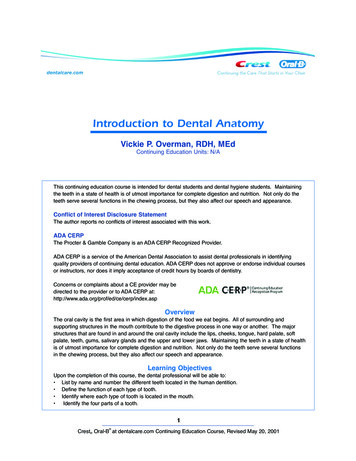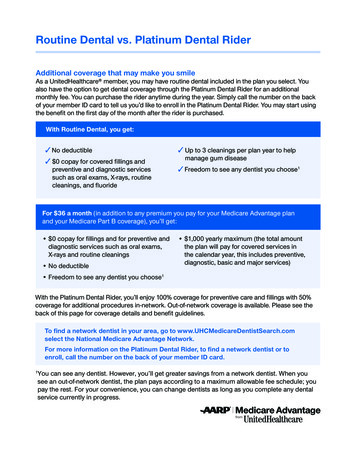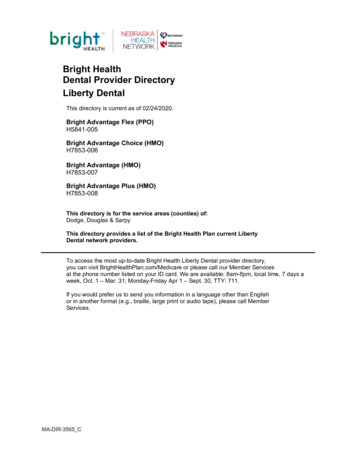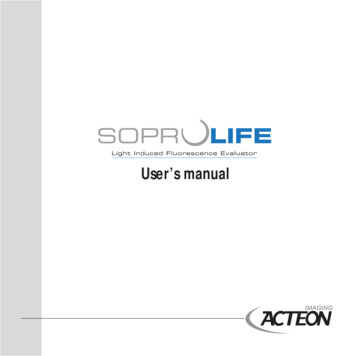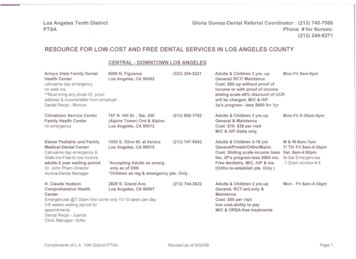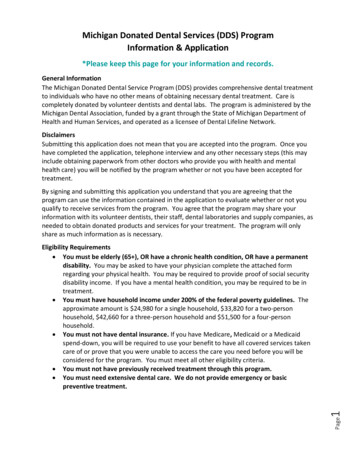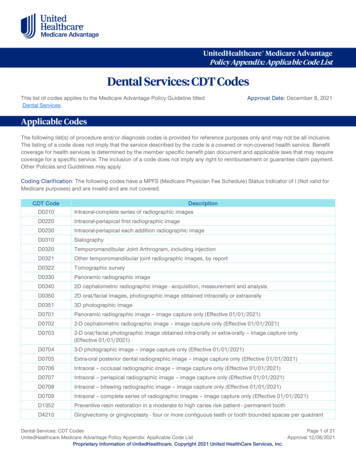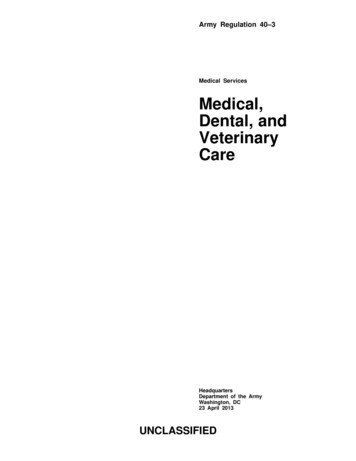
Transcription
Army Regulation 40–3Medical ServicesMedical,Dental, andVeterinaryCareHeadquartersDepartment of the ArmyWashington, DC23 April 2013UNCLASSIFIED
SUMMARY of CHANGEAR 40–3Medical, Dental, and Veterinary CareThis major revision, dated 23 April 2013-oRequires that The Surgeon General appoint the Consultant, Blood Program andDirector, Army Blood Program (para 5-2a(6)).oAdds qualifications for the Director, Army Blood Program (para 5-2d(1)).oAdds qualifications for the Chief, Blood Services and for Blood Donor Centerofficers in charge (para 5-2f(2)).oClarifies that the regional medical command blood manager has overallresponsibility for managing credits throughout their respective region (para5-2f(15)).oRequires commanders to ensure that reservists mobilized in support of theArmy Blood Program are used in the appropriate blood program position (para 52f(16)).oProvides guidance on establishing or terminating an Army Medical Departmentlibrary property account (para 7-10).oRevises the mission of the nutrition care division (para 8-2).oExpands duties of the nutrition care divisions’ noncommissioned officers incharge (para 8-4c).oAdds military treatment facility staff to those authorized to eat in amilitary treatment facility’s nutrition care division (para 8-5a).oRevises nutrition care division documentation requirements (paras 8-5c, 89e, and 8-16).oRequires DD Form 1544 (Cash Meal Payment Book) for use with manual cashcollections (para 8-6c).oRevises payment requirements for ambulatory patients (para 8-20).oAuthorizes foreign national embassy staff to be listed for transplantationthrough the Army-Navy Transplant Service (para 9-1b(7)).oUpdates medical and administrative living donor requirements (paras 9-1b(4)and 9-1c(1)).oDefines and separates from kidney donation requirements the provisions forliving hepatic donation (para 9-2d(5)(b)).oRevises guidance on recording and reporting medication errors (para 11-9b).
oRevises guidance on controlled substances (para 11-10 and app B).oAdds guidance relevant to dispensing procedures (para 11-14e).oRevises guidance on refill prescriptions from other medical treatmentfacilities (para 11-14g).oSpecifies the age at which an accompanied child can pick up prescriptions(para 11-14h).oUpdates guidance on pharmacy support to mobilizing and deploying personnel(para 11-26).oRevamps pharmacy and medication automation procedures (para 11-28).oClarifies cardiac life support training requirements for boarded emergencymedicine physicians (tables 13-1 and 13-2).oIncorporates the Laboratory Response Network into medical laboratorymanagement (chap 14).oAdds food defense to veterinary services (para 15-2).oMakes administrative revisions (throughout).
*Army Regulation 40–3HeadquartersDepartment of the ArmyWashington, DC23 April 2013Effective 23 May 2013Medical ServicesMedical, Dental, and Veterinary CareHistory. This publication is a majorrevision.Summary. This regulation, addressingmultiple medical programs, has been revised to update policy on the Army BloodPrograms, medical libraries, nutrition caremanagement, The Army Organ Transplantand Organ/Tissue Donation Programs,pharmacy and medication management,emergency medical services, medical laboratory management, veterinary care, andair ambulance vehicles.Applicability. This regulation applies tothe Active Army, the Army NationalGuard/Army National Guard of the UnitedStates, and the U.S. Army Reserve, unlessotherwise stated. It also applies to medicaldepartment activities, medical centers,dental activities, veterinary activities, andother Army Medical Department organizations. This publication is applicable during mobilization.ContentsProponent and exception authority.The proponent of this regulation is TheSurgeon General. The proponent has theauthority to approve exceptions or waiversto this regulation that are consistent withcontrolling law and regulations. The proponent may delegate this approval authority, in writing, to a division chief withinthe proponent agency or its direct reporting unit or field operating agency, in thegrade of colonel or the civilian equivalent.Activities may request a waiver to thisregulation by providing justification thatincludes a full analysis of the expectedbenefits and must include formal reviewby the activity’s senior legal officer. Allwaiver requests will be endorsed by thecommander or senior leader of the requesting activity and forwarded throughtheir higher headquarters to the policyproponent. Refer to AR 25–30 for specificguidance.Army internal control process. Thisregulation contains internal control provisions and provides an Internal ControlEvaluation for use in evaluating key internal controls (see appendix C).Supplementation. Supplementation ofthis regulation and establishment of command and local forms is prohibited without prior approval from The SurgeonGeneral of the Army, 7700 ArlingtonBoulevard, Falls Church, VA22042–5142.Blank Forms) directly to The SurgeonGeneral of the Army, 7700 ArlingtonBoulevard, Falls Church, VA22042–5142.Committee management. AR 15-1 requires the proponent to justify establishing/continuing committee(s), coordinatedraft publications, and coordinate changesin committee status with the U.S. ArmyResources and Programs Agency, Department of the Army Committee Management Office (AARP-ZA), 9301 ChapekRoad, Building 1458, Fort Belvoir, VA22060-5527. Further, if it is determinedthat an established “group” identifiedwithin this regulation, later takes on thecharacteristics of a committee, as found inthe AR 15-1, then the proponent will follow all AR 15-1 requirements for establishing and continuing the group as acommittee.Distribution. This publication is available in electronic media only and is intended for command levels A, B, C, D,and E for the Active Army, the ArmyNational Guard/Army National Guard ofthe United States, and the U.S. ArmyReserve.Suggested improvements. Users areinvited to send comments and suggestedimprovements on DA Form 2028 (Recommended Changes to Publications and(Listed by paragraph and page number)Chapter 1Introduction, page 1Purpose 1–1, page 1References 1–2, page 1Explanation of abbreviations and terms 1–3, page 1*This regulation supersedes AR 40–3, dated 22 February 2008.AR 40–3 23 April 2013UNCLASSIFIEDi
Contents—ContinuedResponsibilities 1–4, page 1Chapter 2Advance Directives, Do-Not-Resuscitate, and Withhold/Withdraw Orders, page 1Introduction 2–1, page 1Responsibilities 2–2, page 1Policy 2–3, page 1Documentation 2–4, page 2Review 2–5, page 2Abatement decisions for patients with decisionmaking capacity 2–6, page 2Abatement decision for incapable patients 2–7, page 2Education 2–8, page 3Active duty patients 2–9, page 3Additional guidance 2–10, page 3Chapter 3Army Aviation Medicine Program and Medical Care of Aviation Personnel, page 3Program concept 3–1, page 3Responsibilities 3–2, page 3Aeromedical physician assistants 3–3, page 4Flight medical aidman 3–4, page 4Flight surgeon clinical duties 3–5, page 4Flight surgeon nonclinical duties 3–6, page 5Supervising medical care for aviation personnel 3–7, page 5Fitness for flying duty 3–8, page 6Federal Aviation Administration medical examinations and certificates 3–9, page 6Chapter 4Auditory Evaluation and Hearing Aids, page 7Auditory evaluation and treatment facilities 4–1, page 7Disposition of patients with hearing impairment 4–2, page 7Procurement of hearing aids 4–3, page 7Records of hearing aid issue 4–4, page 7Repair and replacement of hearing aids 4–5, page 7Accountability and responsibility 4–6, page 8Chapter 5Army Blood Programs, page 8General 5–1, page 8Responsibilities 5–2, page 8Policy 5–3, page 11Organization 5–4, page 13Individual blood group and type 5–5, page 13Disposition of blood products 5–6, page 14Exchange or sale of outdated blood plasma 5–7, page 14Chapter 6Dental Care, page 14General 6–1, page 14Authorization of care 6–2, page 15Dental care priority 6–3, page 15Dental examinations and screenings 6–4, page 15Dental readiness classification 6–5, page 15Dental appointments 6–6, page 16Audit system 6–7, page 16iiAR 40–3 23 April 2013
Contents—ContinuedPreventive dentistry 6–8, page 16Chapter 7Medical Libraries, page 16Purpose 7–1, page 16Applicability 7–2, page 16Objectives 7–3, page 17Responsibilities 7–4, page 17Directives 7–5, page 18Policy 7–6, page 19Personnel 7–7, page 20Collection development 7–8, page 21Management reporting 7–9, page 21Accountability 7–10, page 21Procurement 7–11, page 22Chapter 8Nutrition Care Management, page 22Purpose and scope 8–1, page 22Mission 8–2, page 22Organization and functions 8–3, page 22Responsibilities 8–4, page 22Persons authorized to eat in the military treatment facility’s nutrition care division 8–5, page 23Cash collections 8–6, page 23Personnel management 8–7, page 23Standard hospital diets 8–8, page 24Clinical dietetics management 8–9, page 24The military treatment facility menu 8–10, page 25Subsistence and supply management 8–11, page 25Food management 8–12, page 25A la carte meal service 8–13, page 26Ration accounting 8–14, page 26Food cost management 8–15, page 27The nutrition care division activities report 8–16, page 27Nutrition care division contracts 8–17, page 27Termination of military treatment facility nutrition care operations 8–18, page 27Other food service support 8–19, page 27Subsistence for ambulatory patients on observation or receiving care in the emergency department, speech pathology,gastroenterology, or other special clinics 8–20, page 28Food service support during mass casualty 8–21, page 28Food service support for military training exercises 8–22, page 28Chapter 9The Army Organ Transplant and Organ/Tissue Donation Programs, page 28The Army-Navy Organ Transplant Service 9–1, page 28The Army Organ and Tissue Donation Program 9–2, page 29Chapter 10Orthopedic Footwear, page 32Persons eligible for orthopedic footwear 10–1, page 32Number of pairs of orthopedic footwear furnished 10–2, page 33Types of orthopedic footwear available 10–3, page 33Procedures for obtaining orthopedic footwear 10–4, page 33Replacement orders 10–5, page 34Delivering footwear after patient transfer 10–6, page 34AR 40–3 23 April 2013iii
Contents—ContinuedOrthopedic adjustments to standard footwear 10–7, page 35Repairing orthopedic footwear 10–8, page 35Orthopedic lasts and patterns 10–9, page 35Moving active duty military members to the Department of Veterans Affairs Network Prosthetics Center 10–10,page 35Chapter 11Pharmacy and Medication Management, page 35Purpose and applicability 11–1, page 35Responsibilities 11–2, page 35Monetary collections for medicine 11–3, page 36Personnel 11–4, page 36Pharmacy benefits 11–5, page 37Basic core formulary and committed use requirement contracts 11–6, page 37Pharmacy and therapeutics committee 11–7, page 37Therapeutic dietary supplements 11–8, page 38Performance improvement 11–9, page 38Controlled substances 11–10, page 39Individuals authorized to write prescriptions 11–11, page 39Signatures 11–12, page 40Prescription writing 11–13, page 40Dispensing 11–14, page 41Mailing prescriptions 11–15, page 42Prescription transfers 11–16, page 42Labeling 11–17, page 43Numbering and filing 11–18, page 43Stock record 11–19, page 43Disposition of drugs collected from patients 11–20, page 43Pharmacy supply and support functions 11–21, page 43Inspection and disposition of prescription files and records 11–22, page 44Investigational drugs 11–23, page 44Patient counseling 11–24, page 44Drug samples 11–25, page 44Pharmacy support to mobilizing and deploying personnel 11–26, page 44Field pharmacy operational considerations 11–27, page 45Pharmacy and medication automation 11–28, page 45Chapter 12Use and Control of Psychological Test Materials, page 46Purpose and scope 12–1, page 46Objective 12–2, page 46Policy 12–3, page 46Supplemental conditions of psychological test use 12–4, page 46Qualifications of occupations and specialties in psychological testing 12–5, page 47Chapter 13Emergency Medical Services, page 48Applicability 13–1, page 48Scope 13–2, page 48Policy 13–3, page 48Chapter 14Medical Laboratory Management, page 51General 14–1, page 51Applicability 14–2, page 51ivAR 40–3 23 April 2013
Contents—ContinuedResponsibilities 14–3, page 51Accreditation policies 14–4, page 53Laboratory personnel 14–5, page 54Quality control 14–6, page 54Monetary collections for laboratory services 14–7, page 54Improving organizational performance 14–8, page 54Individuals authorized to order laboratory tests 14–9, page 55Self-performance of laboratory tests 14–10, page 55Inspection and disposition of laboratory files and records 14–11, page 55Chapter 15Veterinary Care, page 55General 15–1, page 55Veterinary services 15–2, page 56Authorizing care 15–3, page 56Providing veterinary medical care 15–4, page 56Veterinary training assistance team 15–5, page 56Chapter 16Air Ambulance Vehicles, page 57Purpose 16–1, page 57General 16–2, page 57Authorization 16–3, page 57Operational control 16–4, page 57Equipment 16–5, page 58Chapter 17Placement and Use of Automatic External Defibrillators on Army Installations and Within Army Facilities,page 58Overview 17–1, page 58Authority and guidance 17–2, page 58Responsibilities 17–3, page 58Operational control 17–4, page 59Procurement of automatic external defibrillators 17–5, page 60Legal considerations for the use of automatic external defibrillators 17–6, page 60Additional guidance 17–7, page 60Chapter 18Nursing Administrative Forms, page 60Purpose 18–1, page 60Form description and use 18–2, page 60AppendixesA.References, page 62B.Inventory, Control, and Accountability of Controlled Substances, Select Noncontrolled Medications, andDiagnostic Agents, page 70C.Internal Control Evaluation Checklist, page 83D.Essential Equipment on Aerial Ambulance, page 86Table ListTable 8–1: Meal conversion factors (weights), page 26Table 13–1: Chief, emergency medical services—experience, training, and certification requirements, page 49AR 40–3 23 April 2013v
Contents—ContinuedTable 13–2: Emergency medical services staff physicians—experience, training, and certification requirements,page 49Figure 2:B–3:B–4:B–5:B–6:Example of a completed DA Form 3949–1, page 72Example of a completed DA Form 3949, page 73Sample of a completed DA Form 1296, front, page 76Sample of a completed DA Form 1296, reverse, page 77Example of a completed DA Form 3862, front, page 79Example of a completed DA Form 3862, reverse, page 80GlossaryviAR 40–3 23 April 2013
Chapter 1Introduction1–1. PurposeThis regulation establishes policies, procedures, and responsibilities pertaining to selected Army Medical Department(AMEDD) programs and initiatives. Since policies and procedures contained in this regulation may change conditionsof employment of bargaining unit members, the responsible commander or manager should be aware of and complywith bargaining obligations based on law, regulation, or relevant collective bargaining agreements.1–2. ReferencesRequired and related publications and prescribed and referenced forms are listed in appendix A.1–3. Explanation of abbreviations and termsAbbreviations and special terms used in this regulation are explained in the glossary.1–4. Responsibilitiesa. Responsibilities specific to subject areas addressed in this regulation are delineated in individual chapters andpertain only to policies and procedures described in that chapter.b. Heads of Headquarters, Department of the Army agencies and commanders of Army commands, installations, andactivities will have knowledge of Army Regulation (AR) 340–21 and AR 25–55.Chapter 2Advance Directives, Do-Not-Resuscitate, and Withhold/Withdraw Orders2–1. IntroductionThis chapter sets policy and procedures for the implementation of advance directives and for the initiation of orders tosuspend cardiopulmonary resuscitation (commonly referred to as do-not-resuscitate (DNR) or DNR orders) or towithhold or withdraw life-sustaining treatment.2–2. Responsibilitiesa. The military treatment facility (MTF) commander will provide operational guidance for implementation of thepolicies in this chapter.b. The entire healthcare team (physicians, nursing personnel, administrators, attorneys, chaplains, social workers,and patient representatives) will assist patients and/or surrogate, if the patient is incapable, with healthcare decisions.The physician primarily responsible for the patient’s care is responsible for ensuring that the patient has adequateinformation on which to base his or her decision and that the patient’s wishes are honored so far as possible.2–3. Policya. A patient with decisionmaking capacity has the legal and moral right to participate in medical care decisions,including the right to refuse medical treatment at any time even if the treatment is lifesaving.b. Upon admission, all adult patients (as defined in the glossary) will be informed in writing of their right toparticipate in their healthcare decisions, including the right to accept or refuse medical or surgical treatment, and oftheir right to prepare advance directives.c. The standing order is to resuscitate; resuscitation will be initiated unless there is a written DNR order to thecontrary.d. When a patient will not benefit from treatment, a decision to withhold or withdraw that modality, with theconcurrence of the patient or appropriate surrogate decisionmaker, may be justified and will be fully and accuratelydocumented.e. An abatement order (see glossary) or an advance directive will not affect other treatment decisions. Specificattention will be paid to making respectful, responsive, and competent care available for patients who choose to foregolife-sustaining treatment. Therefore, orders for supportive care will be written separately. All efforts to provide comfortand relief from pain will be provided.f. Only privileged physicians who are members of the medical staff may write an abatement order. Physicians in agraduate medical education status can transcribe a verbal order from a privileged physician.g. Physicians will promptly inform others who are responsible for the patient’s care, particularly the nursing staff,about the abatement decision. All who are responsible for the patient’s care will clearly understand the order, its scope,its rationale, and its implications.AR 40–3 23 April 20131
2–4. Documentationa. Advance directives.(1) The presence or absence of an advance directive and/or the opportunity for the patient to formulate an advancedirective will be documented as part of the admission process. Documentation will be included in the admission clerk’schecklist, the nurse’s intake assessment, and in the progress notes.(2) A copy of the advance directive, if any, will be placed in the inpatient chart (see AR 40–66).(3) A patient will not be coerced into formulating an advance directive.b. Abatement orders.(1) Documentation of the progress notes will explain the medical rationale for the order. It will also show thepatient’s decisionmaking capacity and the concurrence of the patient or surrogate. Any review and consultation by anethics committee will also be documented. (Note: If an ethics committee exists, notify the U.S. Army MedicalCommand (USAMEDCOM) at: Commander, U.S. Army Medical Command (MCHO–CL–C), 2748 Worth Road, FortSam Houston, TX 78234–6010. The notification will include complete contact information for the committee chairperson and committee membership requirements. If no ethics committee exists, the ethics committee function will beperformed as determined by the MTF commander; this information will also
management, The Army Organ Transplant a n d O r g a n / T i s s u e D o n a t i o n P r o g r a m s , p h a r m a c y a n d m e d i c a t i o n m a n a g e m e n t , emergency medical services, medical lab-oratory management, veterinary care, and air ambu

